




| Home | Features | Club Nights | Underwater Pics | Feedback | Non-Celebrity Diver | Events | 30 June 2025 |
| Blog | Archive | Medical FAQs | Competitions | Travel Offers | The Crew | Contact Us | MDC | LDC |

|

|
 
 |
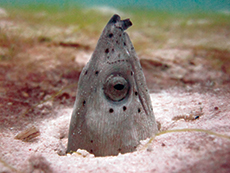 |
ISSUE 13 ARCHIVE - SIPADANRob HuntThe Foreign and Commonwealth Office website dispenses country-specific travel advice in a very English manner, "Probably best to give Afghanistan a miss just now, old chap. Can be a frightful bore with a few bullets flying about and whatnot. Maybe pop along in a week or two for G&Ts after the natives have settled down a bit". The Australian equivalent, on the other hand, takes the opposite approach. In fact, if Australia was outside of Australia, the Australian travel advice for Australia would be this, "Not safe for Australians. Stay at home and watch TV instead. Don't forget to wear your helmet." |
 |
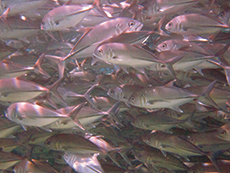 |
Before leaving for Sipadan, Marina checked the Australian site.
It's hard to know how to 'exercise extreme caution at all times'. Try it where you're sitting now; you'll be asleep within five minutes. It's even harder to do when you're staying on the equivalent of a 5-star liveaboard on stilts. I tried applying camouflage face paint and lurking up out of the water with my dive knife between my teeth, like Martin Sheen in Apocalypse Now, but I started attracting the wrong kind of attention. Specifically from the army, who are camped at every resort near Sipadan. So instead, after the day's diving was done, I became more like Charlie Sheen and maintained steadily decreasing levels of vigilance at the bar. |
|
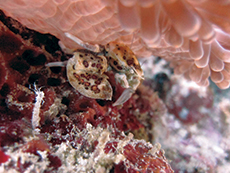 |
All resorts were moved off Sipadan Island itself in 2004, in remarkably
foresighted deference to the fact that it's a national park and having
thousands of chubby food-tubes such as myself drinking beer on it is
unlikely to contribute greatly to the health of the reef. So I was staying
about 20 minutes away on Kapalai, which used to be an island, and
is now a submerged island, remaining between 60cm and 3m below
sea level except for one long sand bar that appears above the surface
for an hour or so during low tide.
I have a curious weakness for lounging around in areas of astonishing natural beauty, suspended a metre or so above azure waters, 45 minutes by speedboat from the nearest advert. I've been to the doctor about it, and he said it's genetic, probably, or a virus or something, and that medical science has failed me, so I'll just have to live with it. In fact the only thing I like better than lounging above clear, blue waters, is diving in them and, as with any liveaboard, that's what the day is built around. |
 |
 |
These days, Sipadan is a difficult act to catch. Your resort will apply
for a share of the 120 diving permits per day which are granted. With
seven or eight resorts in the vicinity, it's clear that you're not going
to be at Sipadan every day and resorts will usually guarantee you a
certain number of permits depending on how long your period of
stay is. Our small group conseguired two permits in six days which
is about standard for the time of year.
Sipadan is where the big things are. The reason for this; the reason why divers run around waving their arms in the air and burbling incomprehensibly about the place, is because Sipadan lies on the edge of a coastal shelf. The island itself is atop a volcanic seamount rising directly from the seabed, 500m or so below, which means lots of walls and pelagic potential. At least that's what I garnered at 6am from the sign pinned up outside the registration office. Whilst that might sound like information easily garnered, the same sign has a diagrammatical map of the area and one of the main features on it is 'Bum Bum Island'. Few are capable of reading on from that point. |
|
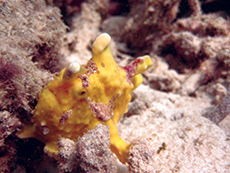 |
Due to time restrictions and the fact that everyone wants to feel they've been given their
money's worth, we found ourselves doing four dives on both days and being back on Kapalai
by 2.30pm, which doesn't leave much room for surface intervals. A surface interval on
Sipadan is a form of torture where all you can think about is getting back in the water and
an hour feels like a day, but I'd still recommend doing them.
It transpired that the best Sipadan moment for me came within the first five minutes of the first dive, when I glanced over my shoulder whilst descending a vertical blue wall to find a grey reef shark drifting by me, pushing through the current whilst barely moving in that sharkish way they have. There were a few other grey reef sharks but they were, as is often the way with these 'sharky-looking' sharks, elusive. Aloof types, hanging around in the distance, rarely popping over to say hello. |
 |
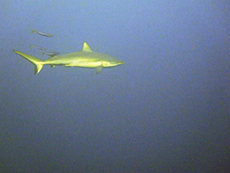 |
The whitetip reef sharks were far more sociable and the shallower parts of the reefs were
generally flooded with them. The same goes for turtles. In fact there were so many turtles,
they're to be properly described as an infestation. By the end of day two, when I'd be
focussing on a turtle that I'd only started looking at because I was bored of looking at the
turtle five metres to its left that had taken the edge off the boredom of looking at the turtle
six metres below that for a while; when I was looking at the turtle and the dive guide would
interrupt me by urgently banging their tank to point out another turtle nearby, well, I started
to understand why Bear Grylls bites their heads off. It's not just because he completely lacks
self-awareness and he thinks it's dramatic; it's because he finds them annoying. Turtles,
I mean. I have no idea if Bear Grylls routinely decapitates dive guides with his teeth.
|
|
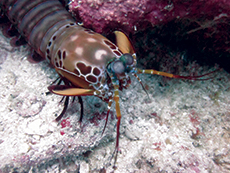 |
The sites are truly stunning, though. Huge vertical walls covered with hard corals, proper blue
water and visibility often in the 40m range. At points the sun is literally blotted out by schools
of jacks and barracuda. The only pelagic specimen I saw was a single baby manta, again on
that first dive, but I felt fairly sure I'd be overwhelmingly delighted to dive Sipadan forever.
Which is why I was so surprised by events the next day.
I started diving because I wanted to see sharks. I still dive because I want to see sharks. Even when I'm diving Wraysbury in February, it's because I like to think it will lead in some oblique fashion to a trip that will culminate in the presence of sharks. So I wasn't particularly interested in the agenda for day three: 'small stuff' on the nearby island of Mabul. I really couldn't see myself scrabbling around looking for something tiny that probably doesn't even have teeth. I was wrong. |
 |
 |
The only real criticism I have for the resort's dive policy (except for the fact that the crew put your
gear together for you which means you'll spend the dive with your first stage chipping away
at the back of your head if you forget to adjust your tank band) is that you'd have up to twelve people per guide. And you'll probably get a different guide each day,
so they have no chance to get to know you and earn themselves tips.
Twelve people is fine when you're monitoring the turtle epidemic on
Sipadan but when you're trawling along the sand looking for something
about the same size as a small lump of sand and which is disguised
as a small lump of sand, twelve people is useless. You're far too far
away from the guide to know what they're pointing at and quickly lose
interest and drift off on your own.
|
|
|
Which is exactly what our little group had been doing. Except on
the third day there was a second guide on our boat who followed
us in our breakaway. As we were floating along, mindlessly glancing
at fragmented bits of coral, the second guide banged his tank and
pointed at a leaf. I snorted derisively. I began composing sarcastic
sections of prose for Tanked Up Magazine. I looked again and realised
it wasn't a leaf, it was a fish that, get this: looks exactly like a leaf. But it
isn't a leaf, it's a fish. Then there was a bit of boring-looking coral. But
inside the coral was a harlequin shrimp. I'd always wanted to see
a harlequin shrimp; I just hadn't realised it before that moment. I began
shoving my dive buddies out of the way to get closer to the guide. Next
up he found an ornate ghost pipefish. I knew I'd always wanted to see
one of those, I'd just assumed it would never happen. After watching
a giant mantis shrimp strike at a piece of squid from a hole in the sand,
I was ecstatic. I had discovered muck diving. I couldn't believe it.
Such is the fame of Sipadan, I hadn't even realised that the surrounding islands were so renowned for macro stuff. Whereas before I'd thought of Kapalai, Mabul and Siamil as vague diversions from the true business of Sipadan on days when you couldn't get a permit, I could now see that Sipadan was really a way of breaking up all the wonderful small stuff with some big things to give your macro lens a rest. This was a revelation, and I was hooked. One of the reasons that muck diving is so fun, is that anything that looks like nothing could in fact be something. The difficulty is that almost everything that looks like nothing isn't in fact anything. This is why you need a guide. It's how you accomplish lifetime ambitions like seeing frogfish. Normally I'd say Never Mind, but something else you need is buoyancy control. If you've only just finished your Open Water course and your understanding of diving physics is still at the point where, "this button makes you go up, yes?" Sipadan is probably not the dive trip for you. As you go ricocheting from surface to 20m bottom and back again, bouncing along through the sand and whatever people are trying to look at before flipping over onto your back and waving your limbs around like a particularly graceless cockroach, it's unlikely that you're going to get much benefit from a muck dive in a ripping current. On the last diving day I wished that whoever was organising the dives had taken time to appreciate this, and put the couple with these challenges on a gentle reef dive rather than with us. It wasn't their fault; they shouldn't have been there. But without having the same guide with you every day that can get to know you, who's going to make that call? |
 | |
|
Still, as I sat with a G&T on the balcony that evening, watching an
average of one turtle every two minutes breach the water (more like
soup, now I come to think of it) with a "Pah" a metre or so below
me, I had more serious matters on my mind. I'd yet to see a pygmy
seahorse. They're about the size of your little finger nail and I doubt
they'd inflict much damage with a bite, so I was surprised to find
myself with such a desperate need to see one. But the need was
there. I had to get back soon. Especially soon as it turns out.
You see, the reason there's so much muck diving is because there's so little reef left. What remains in many areas are just fragments: small oases of life; improbable survivors of all the dynamite fishing that's gone on in the past. Dynamite fishing is illegal now, of course, and part of the reason that there's an army base on every island is to enforce that, as well as to help you maintain your extreme caution. So it was a shock, literally, on the safety stop of the penultimate dive, to hear a quick whizzing sound and deafening bang with accompanying shockwave as, somewhere nearby, a 'fisherman' created a new muck diving site from what used to be a coral reef. My advice? Probably best to head over as soon as you can, old chap: it won't be there for long. |
 | |
Previous article « Here's to the Heroes Next article » Fancy a bit on the Sidemount? Back to Issue 13 Index | ||